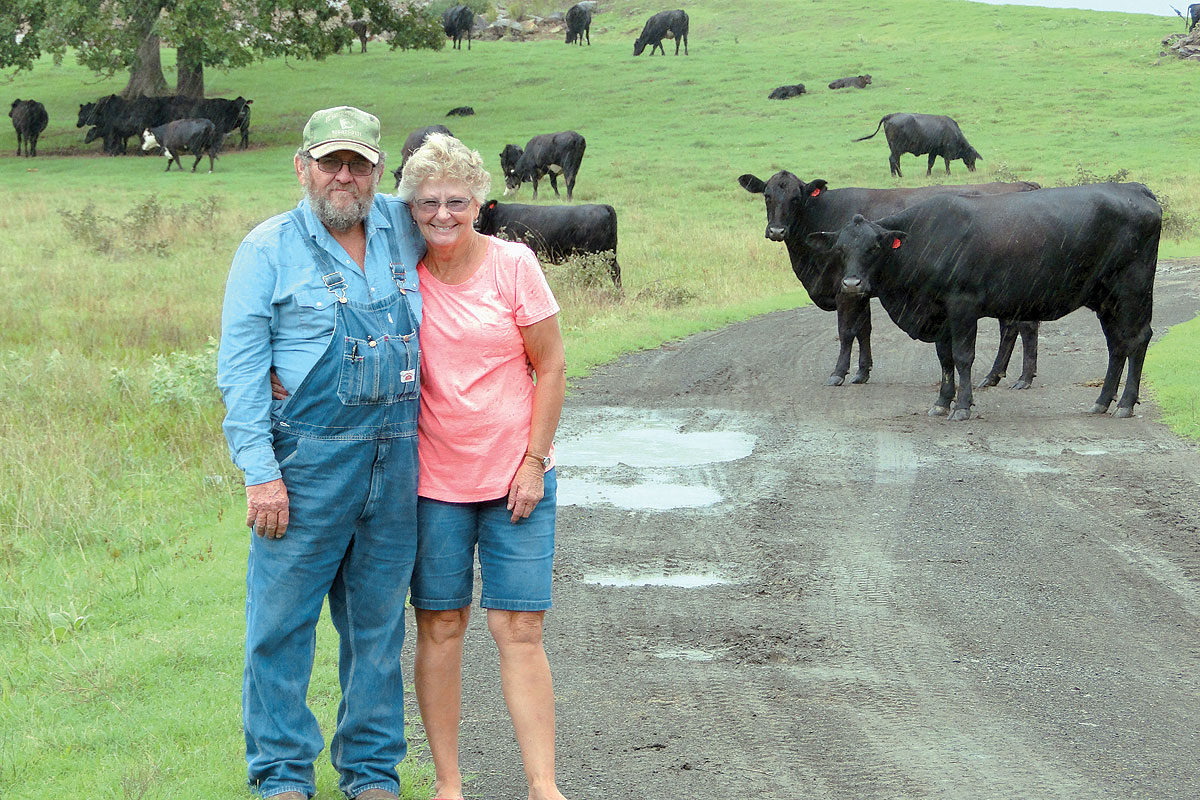
The Corleys left the dairy business 17 years ago and now run more than 600 Brangus/Charolais cows
Kenny and Carol Corley really love cattle, but are also realistic and practical.
They ran a Grade A dairy outside of Booneville, Ark., until 2000 with stocker cattle as a sideline. That dairy still holds a state record for a 4-year-old cow who produced an amazing 38,000 pounds of milk in 305 days.
Realizing the workload was becoming too heavy and profits were shrinking, the couple transitioned to a cow/calf operation while still maintaining a few stockers. However, when the time and circumstances dictate, the couple plans to transition once again, this time to all stockers, which is safer and less work intensive.
Currently the couple owns and leases almost 4,000 acres on which they maintain 600 Brangus and Charolais cross mommas. The females are bred by 40 registered Angus, Red Angus and Charolais bulls.
“I really like those breeds and the calves sell well,” Kenny explained. “Even though we have a commercial herd, we use registered bulls to develop herd genetics and select bulls for passing on good milking and udders, as well as sound feet and legs.”
The Corley’s synchronized breeding program keeps the bulls with the females for three months. Calves are born in March and weaned at 6 months. Then they are backgrounded to 850 pounds.
The herd is divided into eight groups, organized by age and color with the ninth group set aside for “special needs cows,” as Carol calls them. That group is made up of cows that still have the potential to raise good calves in spite of some health or age issues. Cows that do not have that potential or have not bred back are culled and sold at as is any bull too big for the cows or displaying other issues such as age, physical problems or an aggressive temperament. The special needs herd and first-time heifers are fed and checked daily while the other groups are checked every other day. The Corley’s retain 100 heifers a year to replace culls and to promote better herd genetics.
The cattle operation sells 10 loads of calves a year with a typical load being 58 steers or 64 heifers. Calves are usually sold in January and February through a broker and sent to Illinois, Wisconsin and Nebraska, although some animals are sold by private treaty.
“The few stockers we have are used to finish out loads and may be sold at auction if we have any extra,” explained Kenny.
One practice that sets the Corley’s apart from most is the use of a 16 percent protein ration they mill and mix themselves. They book commodities at the local Farmers Co-Op, which include dried distillers’ grain, soybean hull pellets, wheat nibs and corn. Purchases depend upon season, availability and price. The formula is not always constant, with Kenny adjusting based upon experience and herd needs.
Another unusual and important practice came from an old-time and rather authoritative German vet. Years ago, that vet insisted that each vaccine be given separately rather than using a mixed vaccine in a single shot. Because Kenny believes that they get better immunity, he and Carol continue the practice.
The couple agree the most important improvement they have made is a new seven-pen working system that includes Kenny’s self-designed adjustable chute for loading. The highly-practical chute adjusts width and direction, something deeply appreciated by drivers. The setup also contains certified scales which verify weight 10 animals at a time. Finally, the new pens allow for improved safety and are critical since Kenny and Carol work together all of the time.
Because the Corley’s have very large pastures, rotational grazing is unnecessary. The land size also means cattle do not graze on hay ground. The land is mostly Bermuda with some bahia grass. Kenny and Carol clean out 10 poultry houses every year and purchase litter by the dump truck load to use as fertilizer. They also broadcast spray for weeds annually and spot spray for Johnson grass or “anything else that doesn’t belong.”
Kenny believes their biggest challenge is time. Given Kenny’s tendency to overwork, perhaps it’s not surprising that Kenny and Carol’s first date was Carol taking Kenny to the eye doctor after a battery exploded and damaged his eye. At that time Carol was raising replacement dairy heifers and working at the toy factory in Booneville.
“He gets more irons in the fire than we can handle, and I sometimes have to dig my heels in because it’s just the two of us,” Carol said.
However, Carol is no different.
In addition to working side-by-side with Kenny all day, she seems to find the time to keep 22 laying hens and two roosters to supply eggs for the family and friends, not to mention raising three pigs for butchering.
Kenny purchased his first 62 acres in 1960 and chose the land because it was across the road from his grandparents’ dairy, a practical location that held many warm memories.
He started raking hay when only 5 years old and 60 years later is still doing so. One of his favorite memories is driving a 1952 Chevy a four-speed pickup down his grandfather’s rows of corn. He was so small he had to use two feet to push the clutch while people picked corn and threw it in the back.
Cows are not Kenny and Carol’s only source of pleasure. Another is Carol’s two daughters, four grandchildren and one great-grandchild.
Part of the fun is Kenny performing AI on their registered Herefords to supply the kids with show animals.
Another is using AI with bucking stock cows who have produced a little bull and a heifer out of Little Yellow Jacket for future bucking stock, something they both love and share a passion for.
Their days may be busy, but the Corley’s are fulfilled living the life they love.






